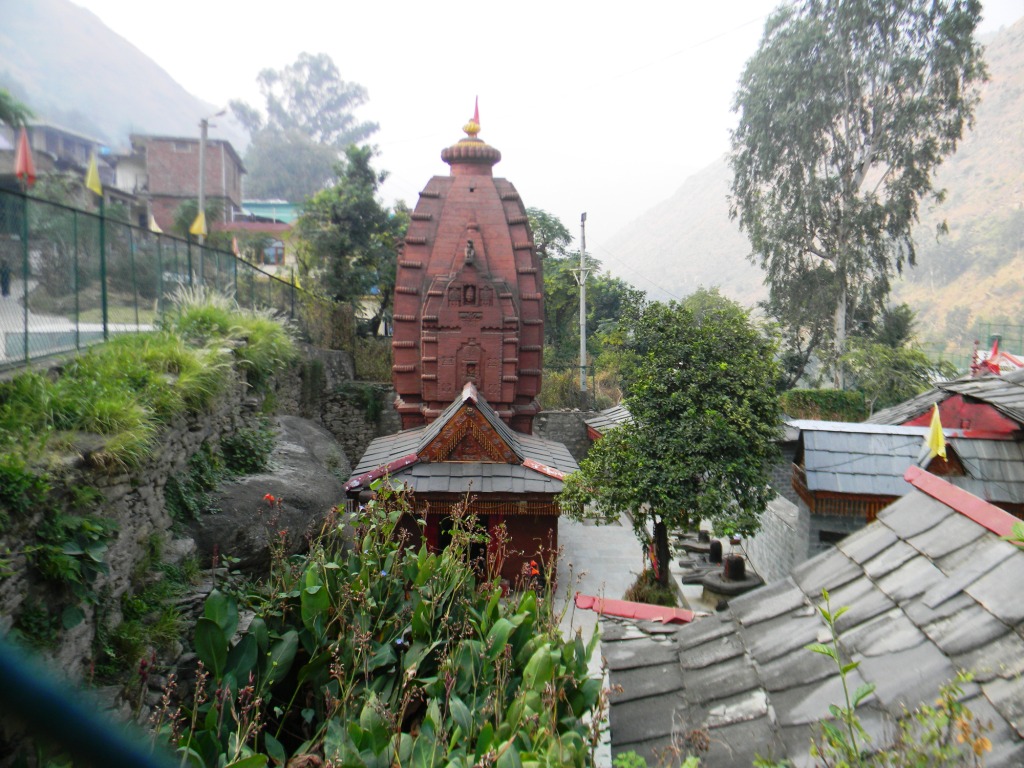
My 2017 tour to Spiti Valley got started on 1st Nov. About 25 km short of Rampur is Nirath Sun Temple, one of the very few sun temples in North India (the most famous one is Konark in Orissa). The temple atmosphere in early morning is very charming as the priest tells about the history of temple from Mahabharat era. Lord Parashuram is credited with the temple’s initial establishment. The chariot of Sun God is driven by seven horses which is depicted in the main idol.
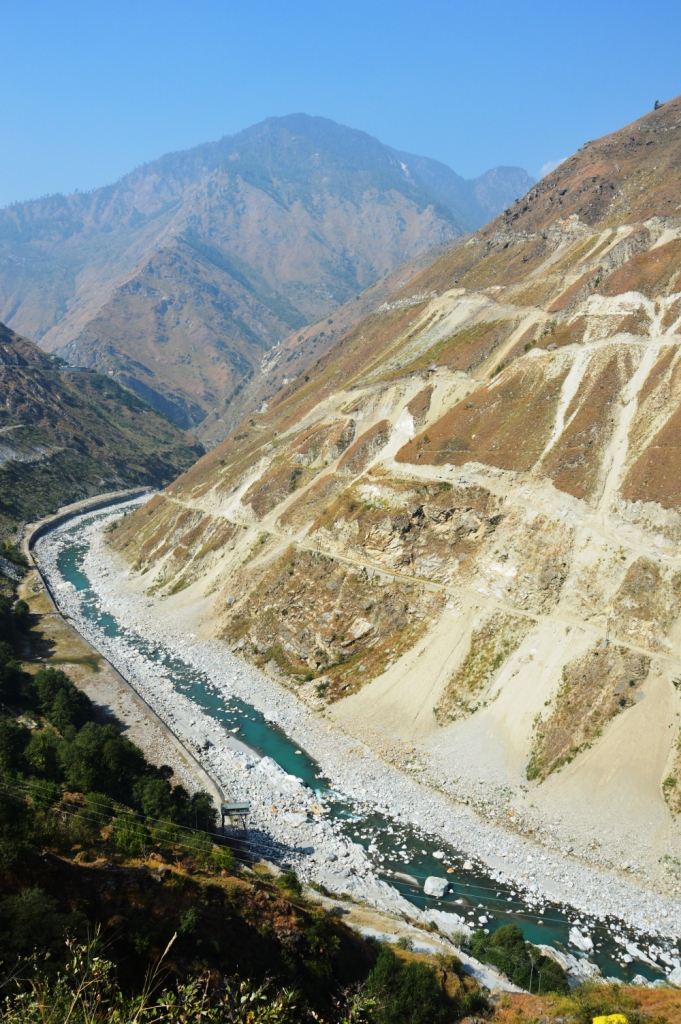
As we leave temple and move along Sutlej river, it is now very gloomy experience as there is very little of river left to be seen. The hydel projects have swallowed it in their tunnels to produce electricity to enlighten our lives!!!! The warm welcome by forest staff at Rekong Peo is some solace of the day.
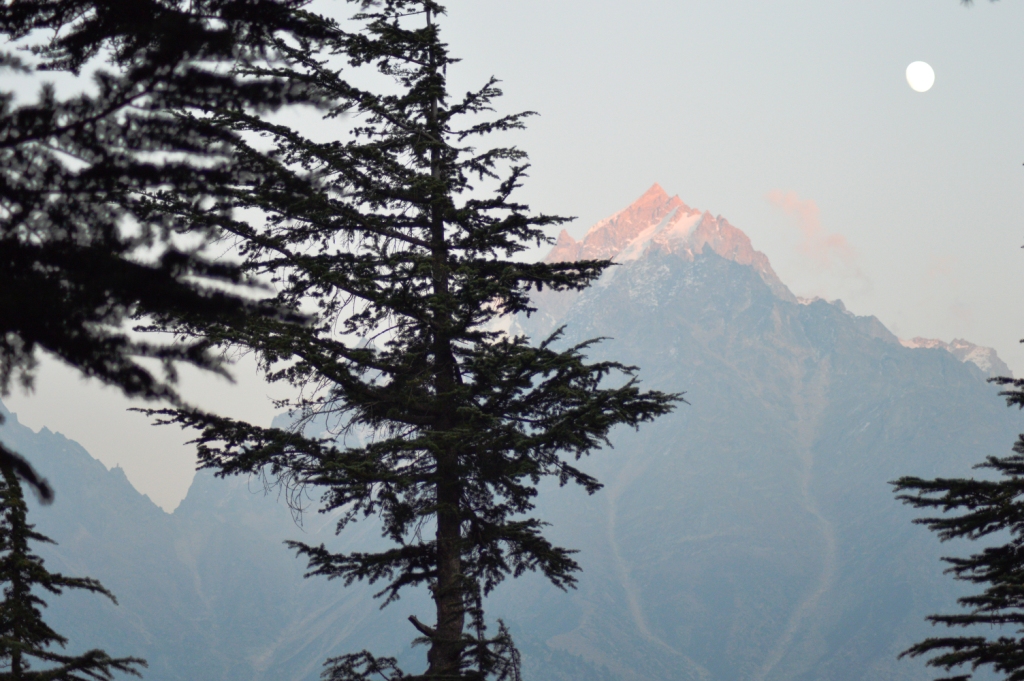
The evening views of Kinner Kailash range from Peo as well as Kalpa are extremely enchanting. The moon rise above this magnificent range enhances the charm of evening. Way back in 1988, I undertook about 120 km long Parikrama of Kinner Kailash which included crossing of Lalanti or Chitkul Pass (about 18000 feet altitude).
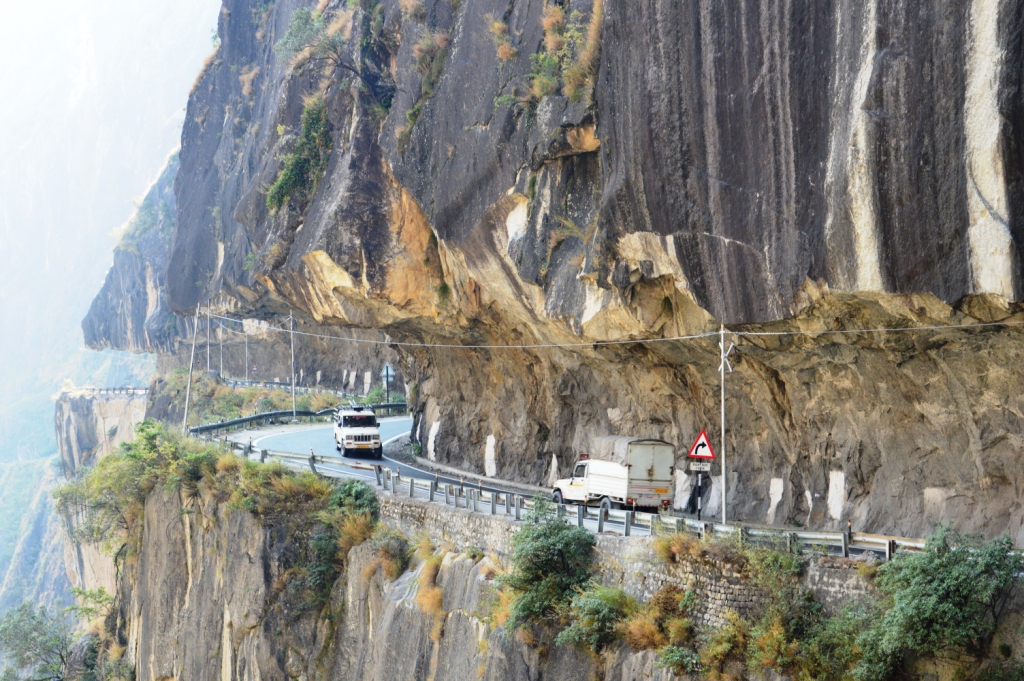
Morning drive from Rekong Peo is along the left bank of Sutlej river till Skiba village. Crossed to the right bank by a suspension bridge at a place which marks far-end of a huge landslide called Khadra Dhank. Above this landslide, the Forest Department has Akpa Rest House at a very commanding site with magnificent Himalayan views.

The area is full of trees of Himalayan Nut Pines or Chilgoza or neoza trees which prefer dry and sunny slopes in an arid zone climate. The scientific name Pinus gerardiana commemorates Captain Patrick Gerard, a British army officer in India.
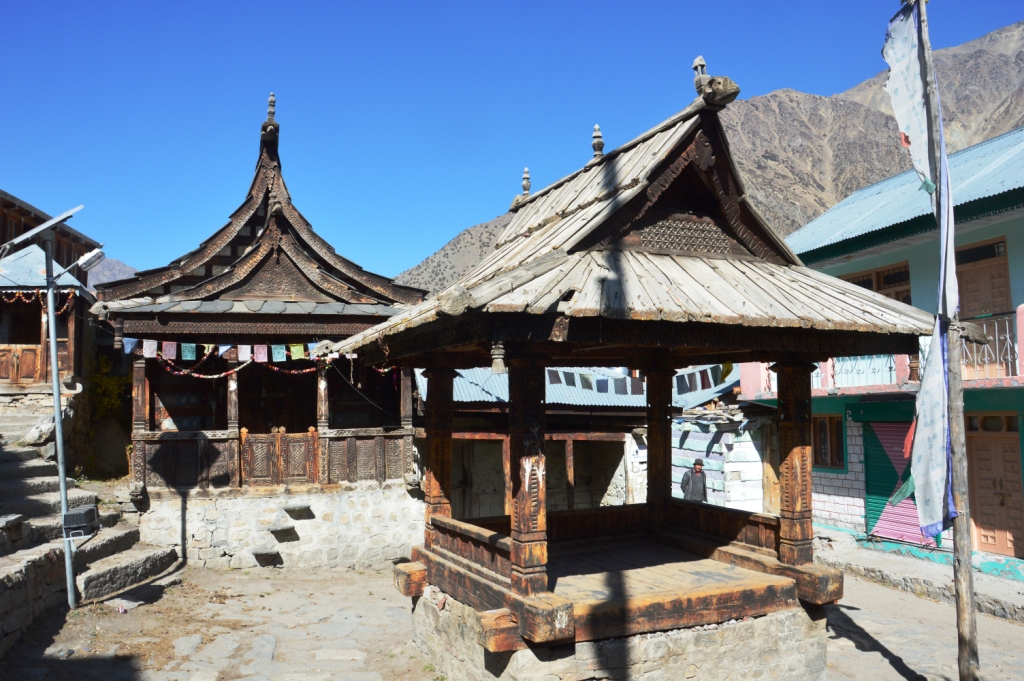
The drive through Chilgoza forest is a very pleasant experience to reach Jangi village with a Gompha and recently renovated village temple. This area is part of the Hindustan-Tibet Road, a great human endeavour which started in 1850 and now part of National Highway 22 from Ambala to Kaurik.
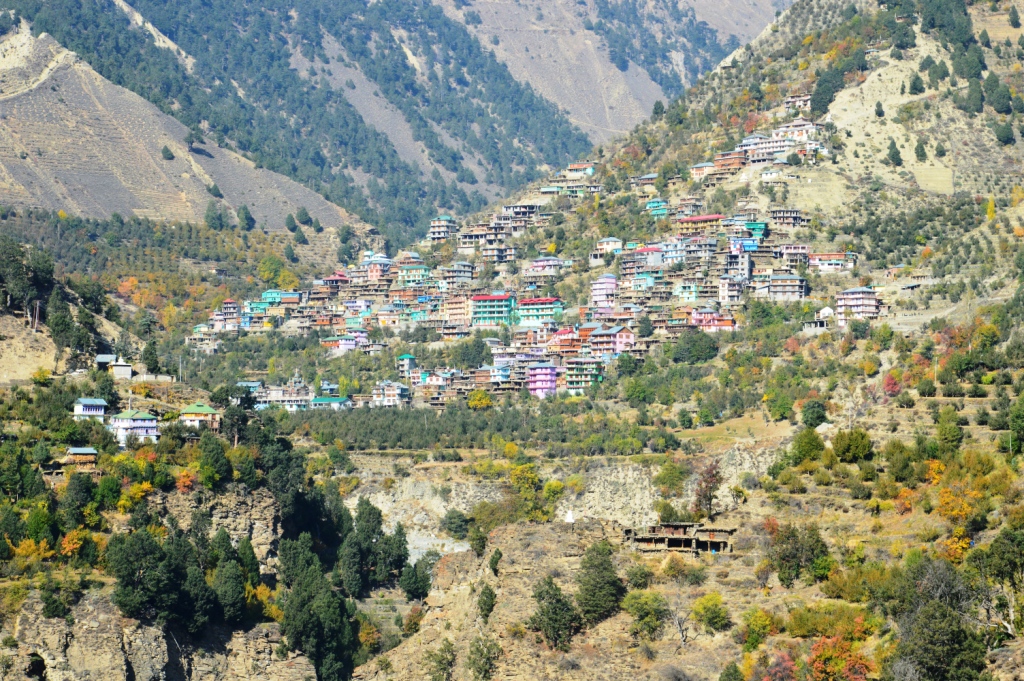
Lippa and Asrang are other two villages which we visited. Exquisite temples dot these villages. However, the most common sight is of apple orchards that are supplying healthier and costlier apples as is claimed by the Apple-Mandi walas.

Our next stop is Khab where Spiti river meets Sutlej coming down from Mt Kailash in Tibet.
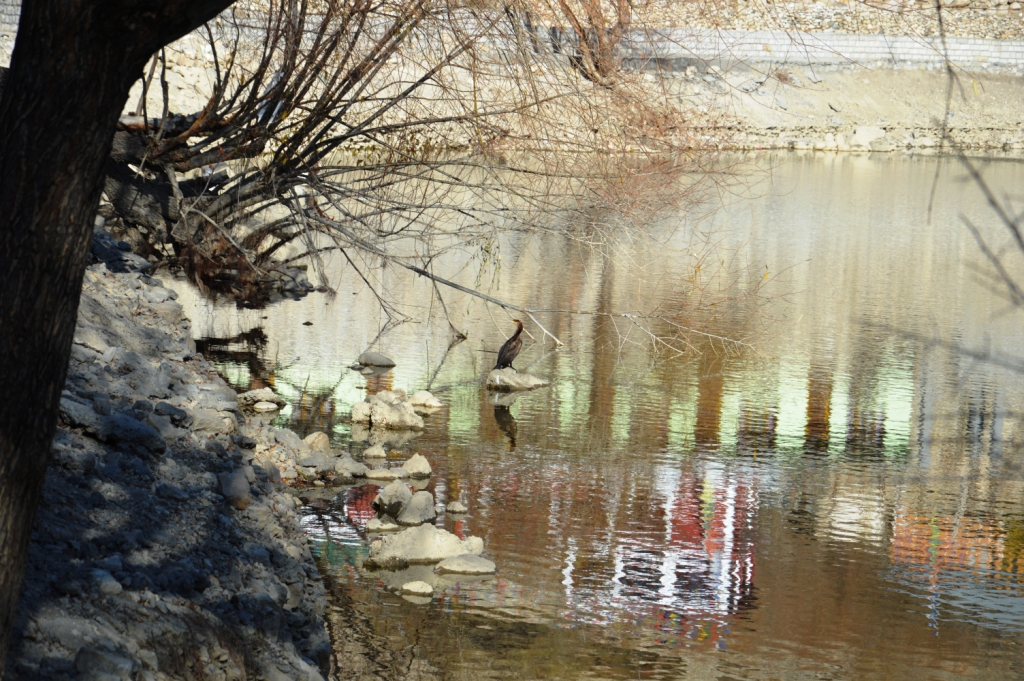
The confluence is at the beginning of Hangrang Valley which has famous villages of Nako (best known for its Lake) and Leo (earlier known for tomato production, now for apples).
Leo Pargil is one of the most prominent peaks of southern end of Zanskar range in Western Himalayas (6816 meters height). The Nako Lake has best of this peak’s reflections.
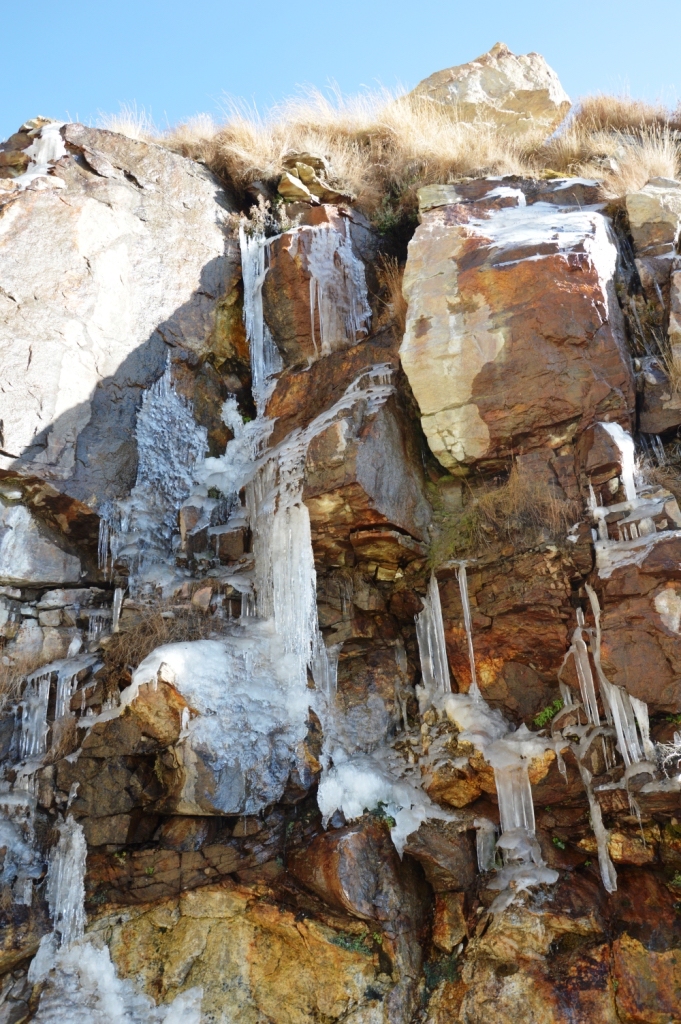
The Hangrang Valley meets with main Spiti Valley near Samdho.
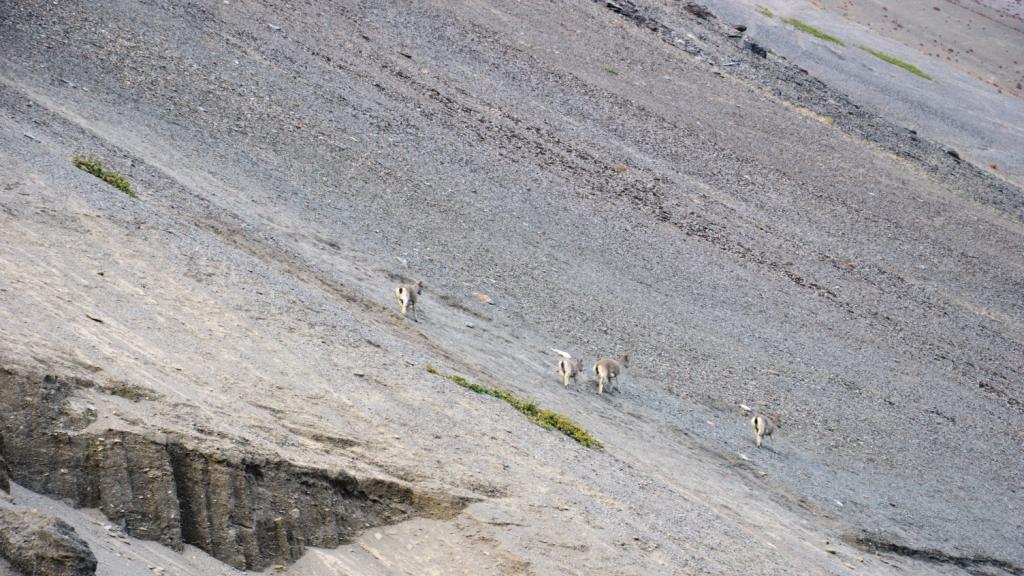
The villages of Hurling and Lari had Blue Sheep (or Nabo as locals call them) on the adjacent slopes as well as in plantation areas.
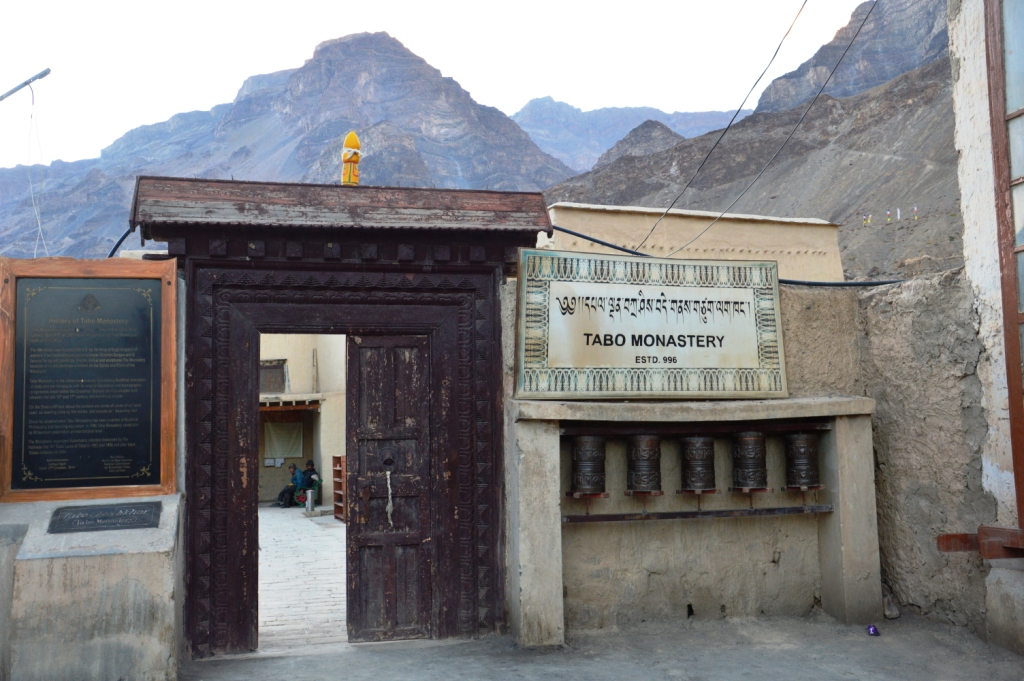
What a lovely journey to Tabo. Great day, indeed.
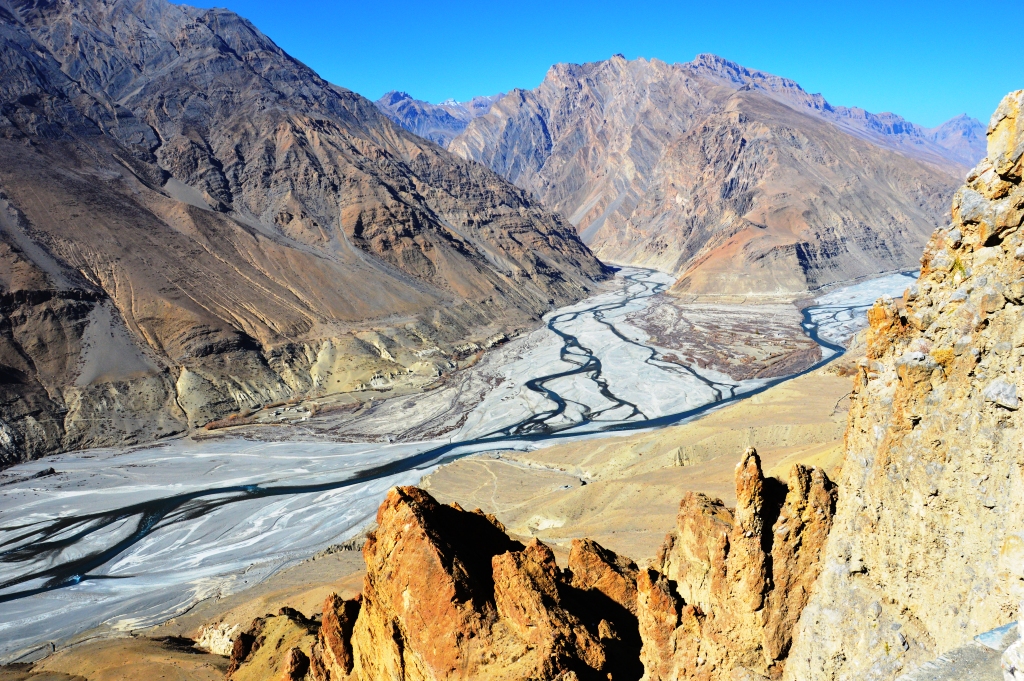
Third day of my Spiti trip was from Tabo to Dhankar Monastery to Sagnam village.
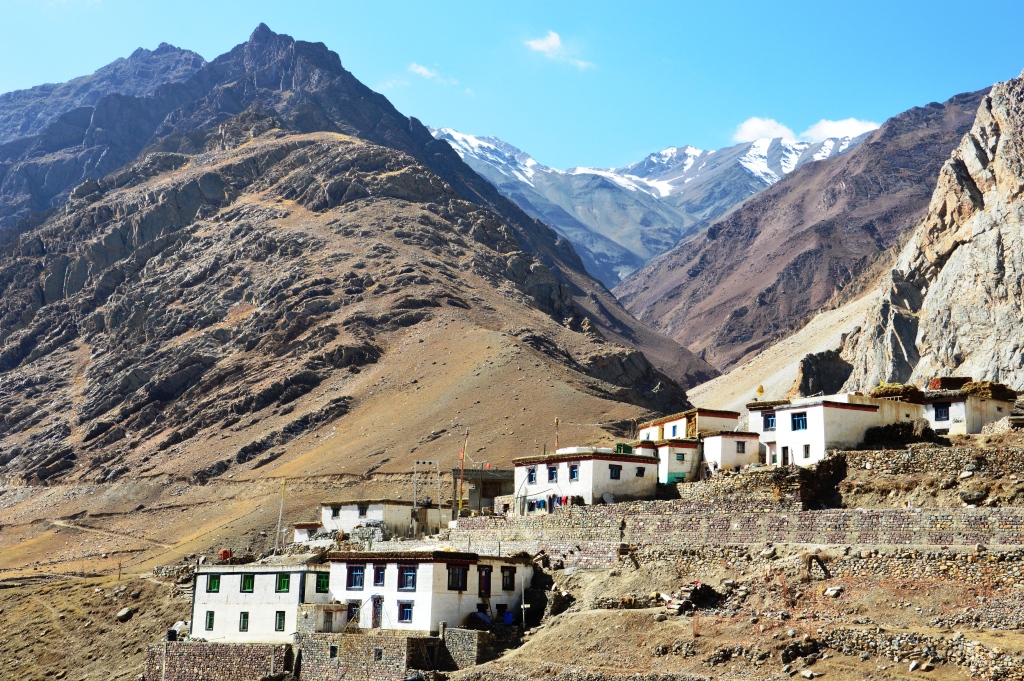
New road has been constructed from Sagnam to Mud which is the last village in Pin Valley.
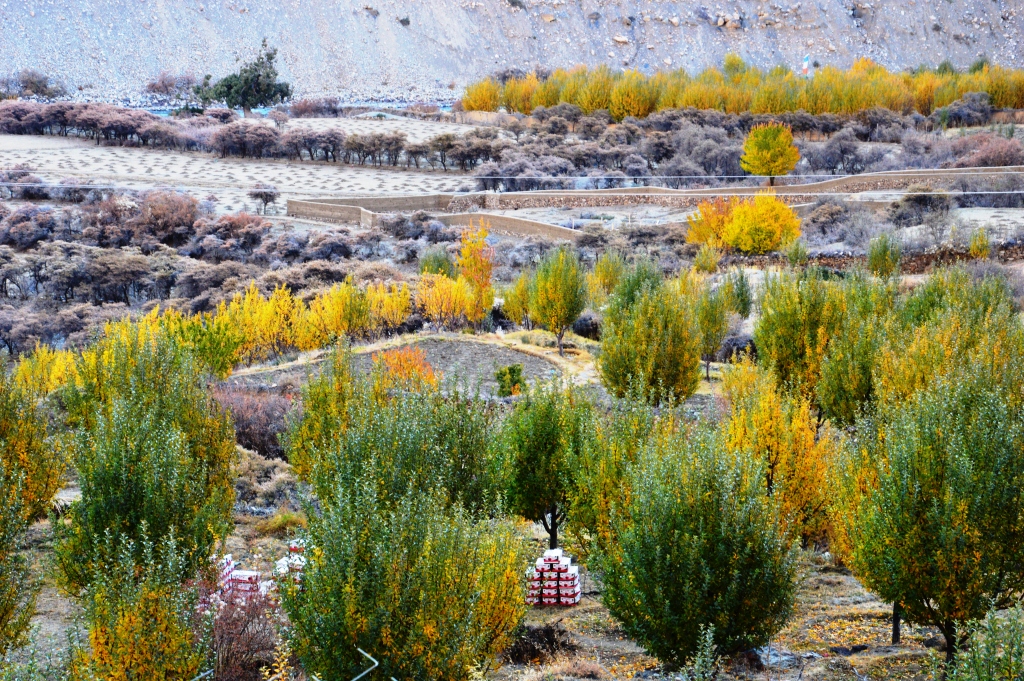
Apple crop is dominating the landscape in autumn with yellowing of apple tree leaves.

The Juniper macropoda trees at Poh are still holding. In past, most of them have been cut for fuelwood purposes which is a shame. Introduction of exotic strains of Poplar in the Spiti Valley is another un-thoughtful step by the government agencies. They consume too much of precious little water available in the cold desert.
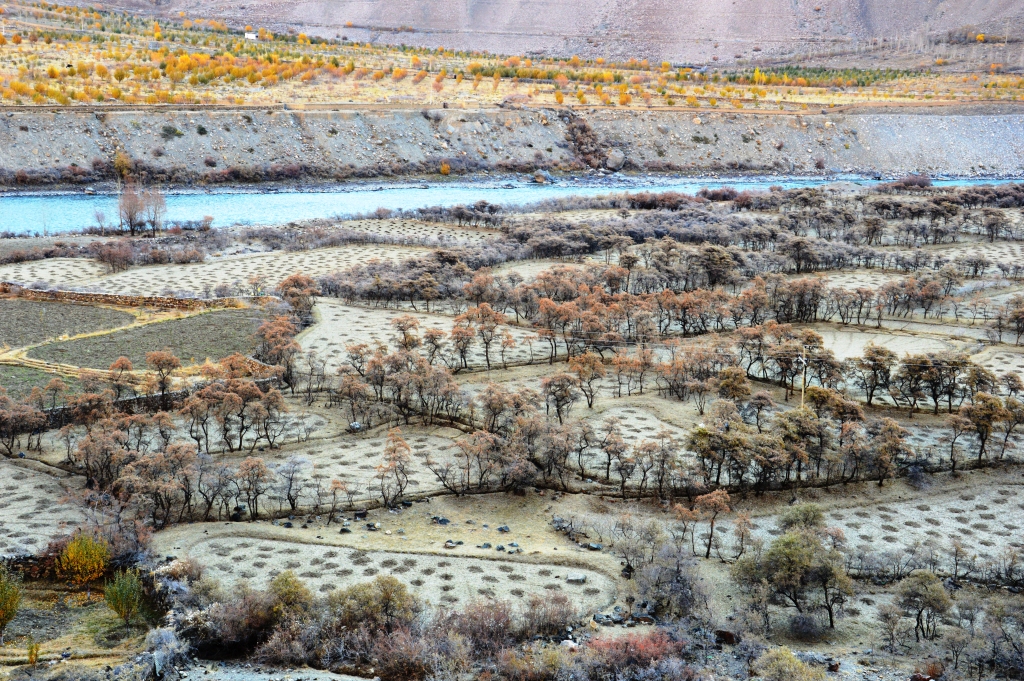
The seabuckthorn shrubs are very good for local consumption as well as for birds. Goldenstedt Redstarts were very much visible feeding on seabuckthorn berries.

The third of November 2017 has azure blue sky with no clouds for an imminent snowfall. This is a very dry spell at the moment in Spiti Valley, a sure sign for changing climate.
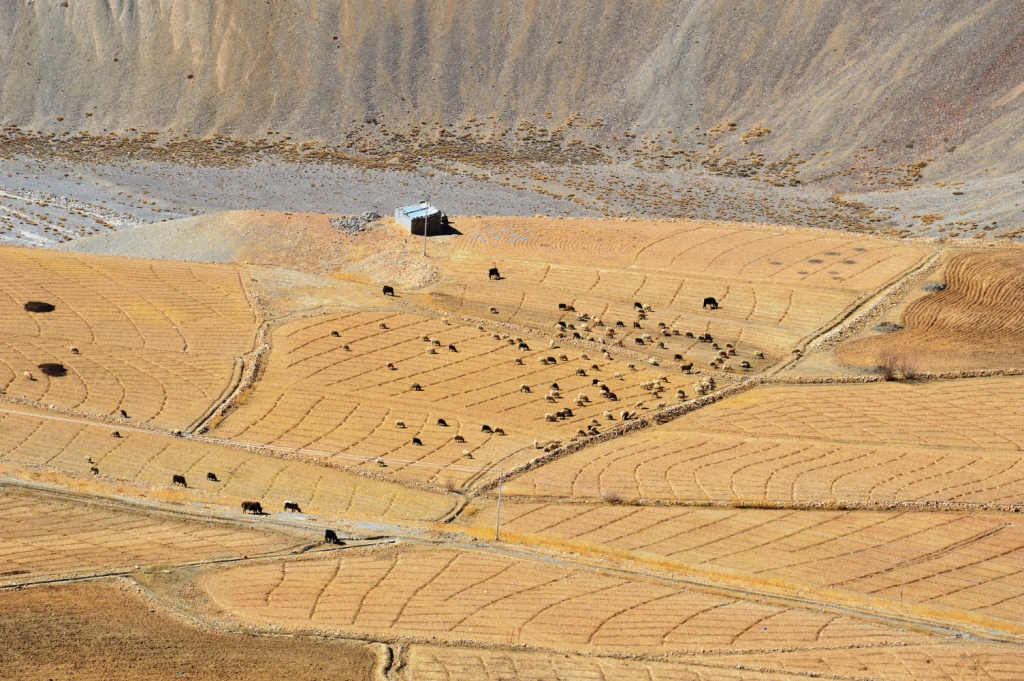
Sighting of two Nayans or Argali sheep above Kibber village made the fourth day of my Spiti tour, the most fruitful day. Once they roamed the Asian highlands in big numbers. At present, their numbers are reduced as they are least tolerant to the human induced disturbances such as herding or competing for the grazing areas.
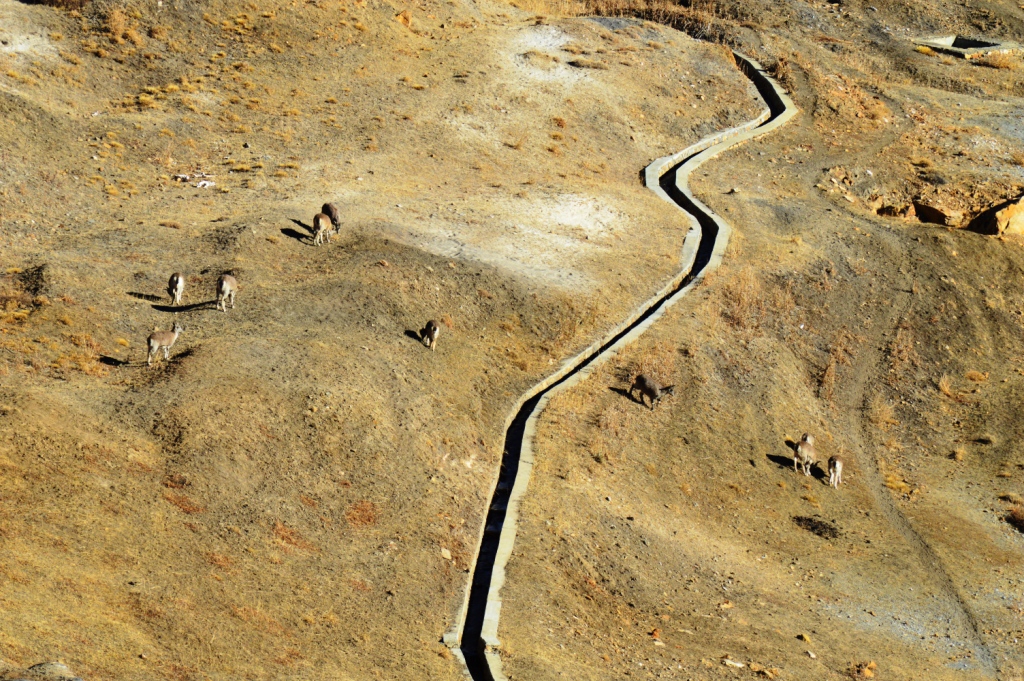
An Argali seen in Himachal Pradesh is news as they mostly stay in Laddkh and Tibet. Parang La above Kibber village is known for the ‘tress-passing’ by Argali along with the free-ranging yaks. In fact, our sighting of two Argalis was close to a group of yaks. At the moment, their coat was of cream colour which may change in winter to grey-brown. The villagers informed that both the animals that we saw were female.
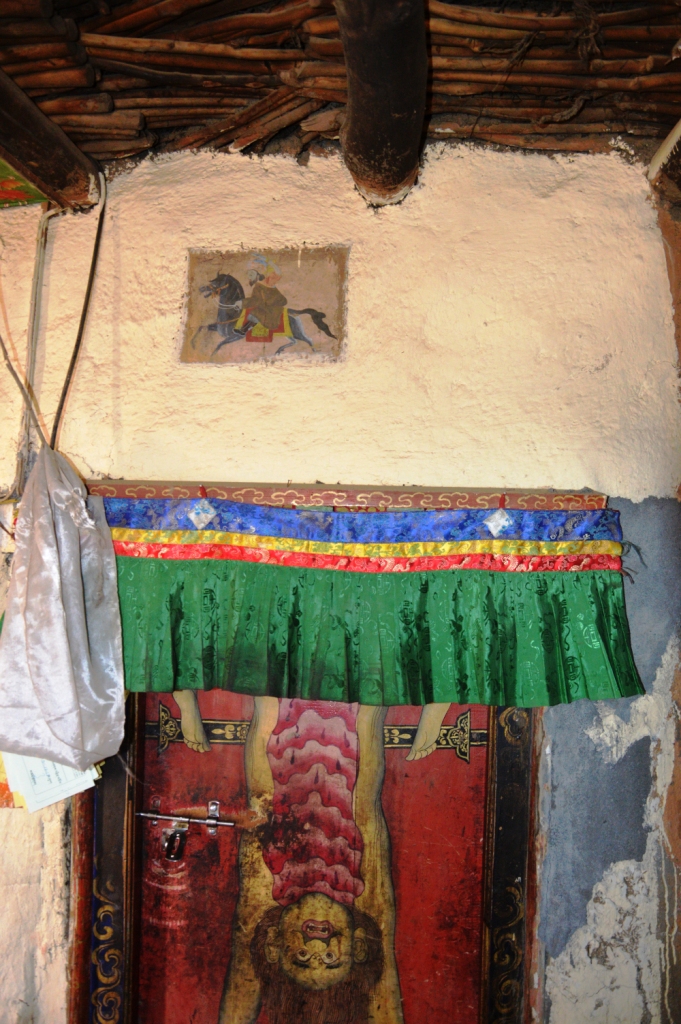
Other excitement on this day was visit to the Tangyud Monastery in Komic village which is highest village in the world connected with motorable road at an alt of 4587 m above the MSl. About 800 years back, the great translator Rinchen Zangpo must have faced many difficulties reaching this place to establish this monastery.
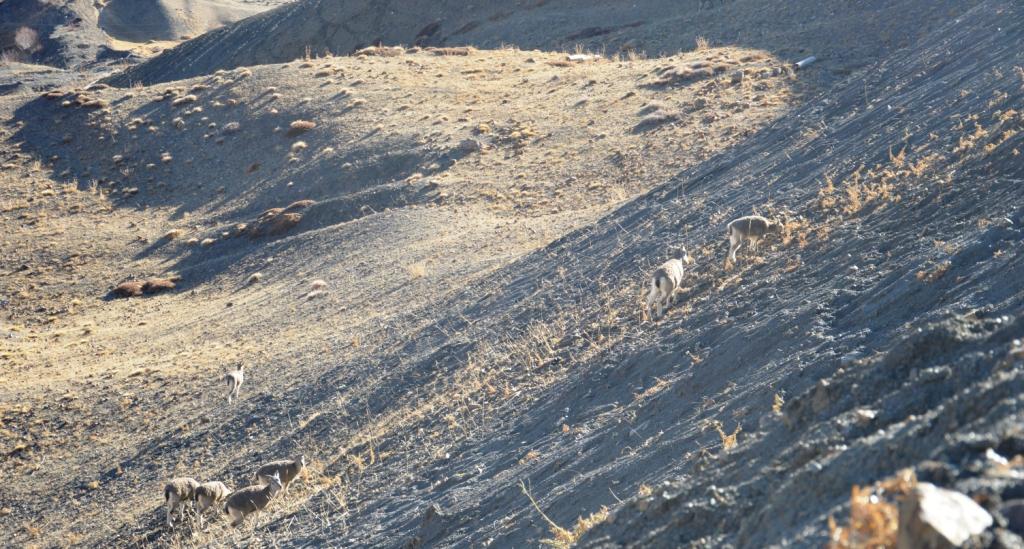
The door of the monastery bears a rather gory painting which is supposed to dispel all the ill spirits of the area. And on top of this door is a painting of none other than Changiz Khan as we were informed by the lama (indicating possible origin of monastery in 14th century under Mongol patronage) . He also told us about the Matrey Buddha or Future Buddha who looks after the people of Komic. Anyway, the place is of exceptional and superlative beauty with an unhindered view of surrounding landscape with deep canyons, and mountains. Truly delighted to be here where I came with my family about five years ago.

CCKN or Cho Cho Kha Nilda peak (6303 m high) can be seen from most of the places on the plateau that starts as we reach Hikim village from Kaza.
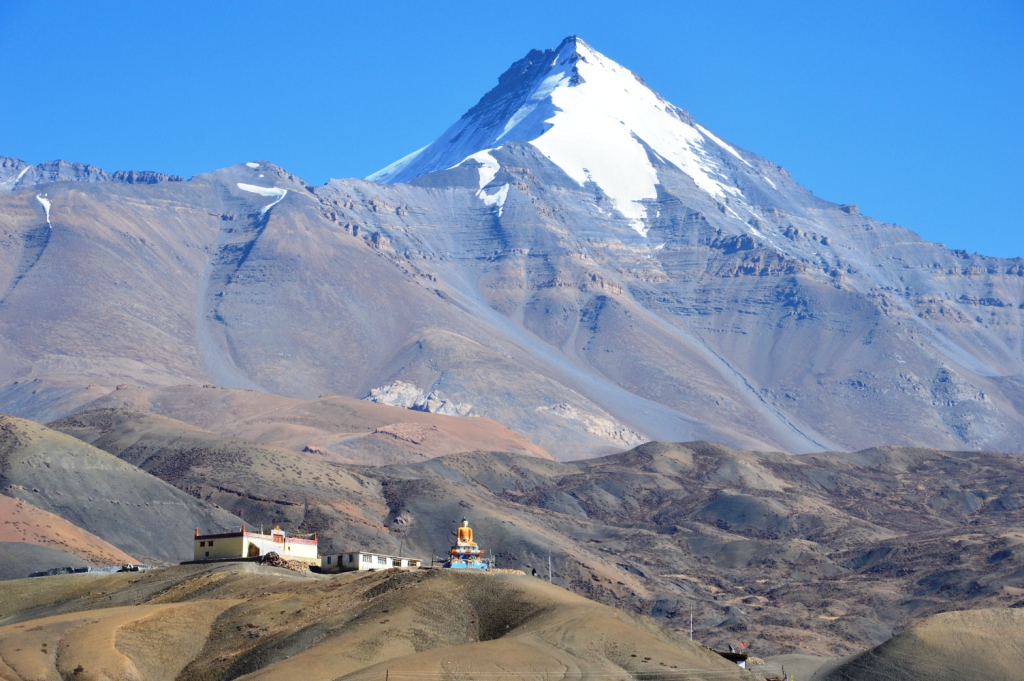
One can easily imagine that the area and high peaks are not easy to negotiate. There have been a few climbing expeditions in past which have scaled CCKN. Of late, we have not heard of mountain-climbers to try on the peaks in this area.
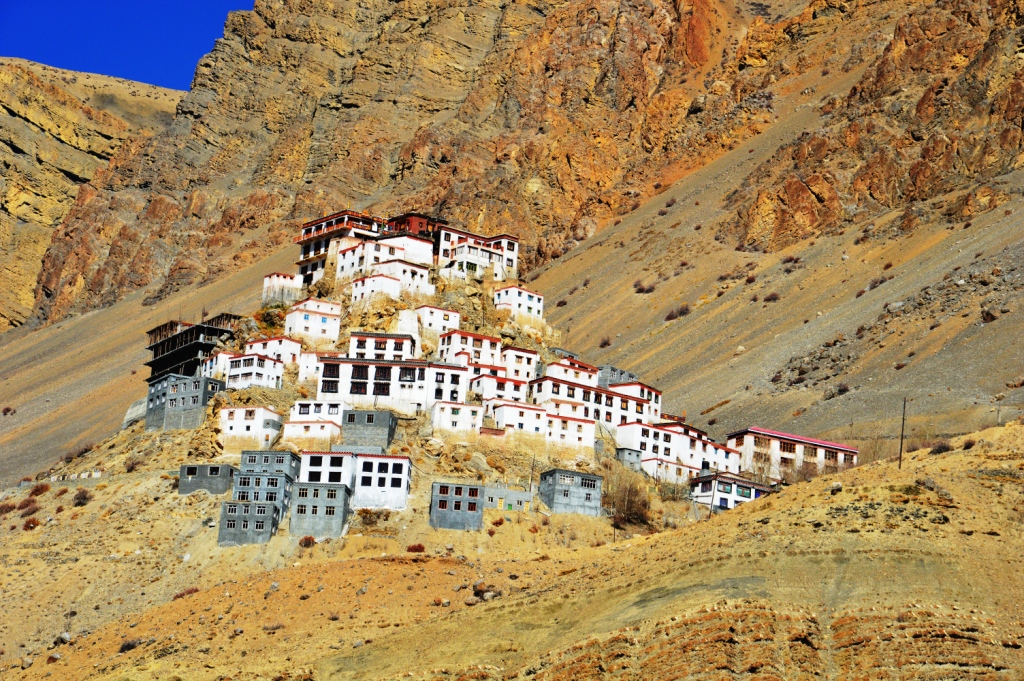
Kee is another famous Gompha located at the alt of 4116 m, largest monastery in Spiti of Gelunkpa School associated with Tibetan Buddhism. It has great views of Spiti river and valley. The head Lama of Kee monastery is very friendly. He blessed me in traditional way and presented a very nice painting. Thanks a lot. T.K. Lochan Tulku is Lotsava Rinpoche at Kee monastery. When he asked his followers (he has a huge following in the area), they declined to collect seabuckthorn berries so that the birds and animals can feed on them. The HP Forest Department can rejoice on such conservation measures coming out of Kee Monastery.
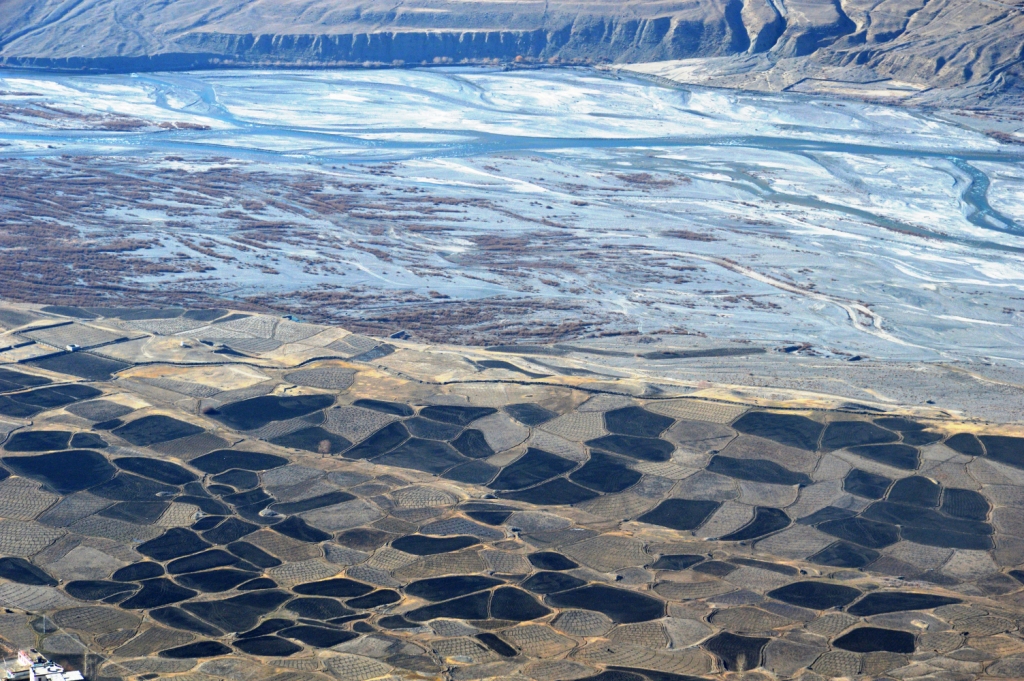
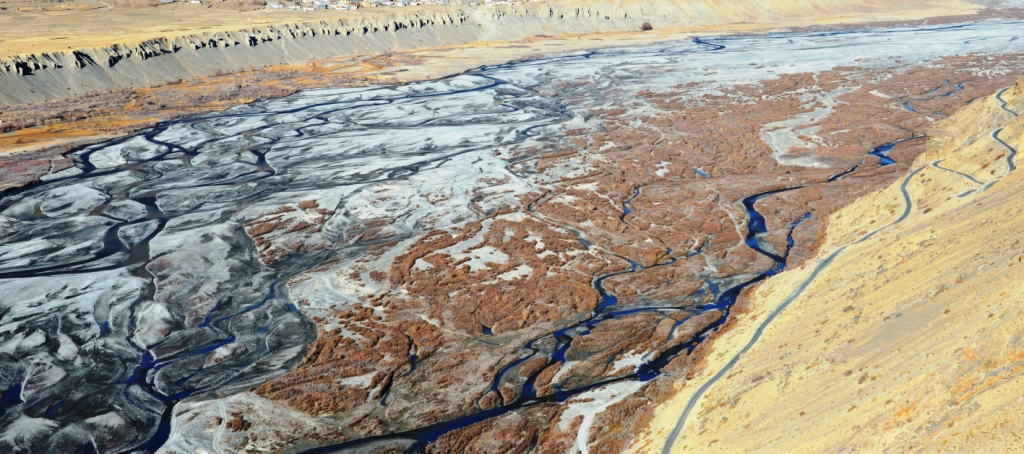
Nature Conservation Foundation (NCF) has its field station in Kibber with many devoted scientists and field workers. At the moment Ajay Bijoor is working on various aspects of people related conservation to help save Snow Leopard in its natural habitat. With him are Kalzang Gurmet and Tenzing Thinley who helped me in Argali sighting. These are wonderful people devoted to nature conservation. A great team to work in tandem with.

Autumn is time when many villagers are preparing their fields (mainly the ladies). It is a treat to see the furrowing of the fields called Nyang. These patterns are to facilitate irrigation. I felt that they have a therapeutic values to relieve our nerves as we watch them. This is a great artistry work involving creative skills.

The bridge between Kibber and Chichim is another feat in the region. It needed a great courage, skill and strength to build such a structure about 120 m in span and about 150 above the ground. When I was there in 2012, there was only one open box which could take me across on a steel wire. It was so scary to see the ground below. Now, our vehicle crossed the bridge within a few seconds.
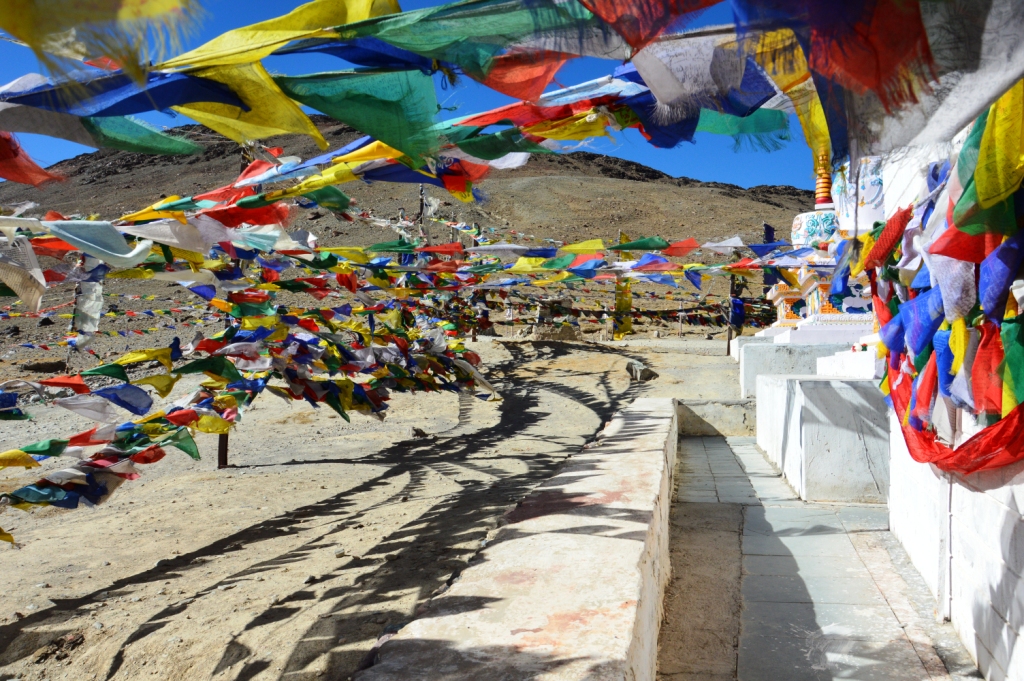
The final leg of this tour was on 5th November, 2017 from Kibber (elevation 4270 metres or 14,200 ft) to Manali (el 2050 m) crossing two major and well known passes of Kunzum (el. 4,590 m or 15,060 ft) and Rohtang (el 3,978 m (13,050 ft). I took the Kibber Chichim Kiato road via the newest suspension bridge of Spiti Valley at Chichim at an elevation of 4145 m or 13596 feet.

Our morning start from Kibber was a bit slow as the road was overtaken by the sheep herds moving to their grazing lands (Ajay Bijoor and his field assistant Tanzing Thinley came with us upto Kiato). Most of the sheep had peculiar sizes of horns which appear to be cross-breeds with the foreign sheep, introduced to improve the local breeds for meat and wool.
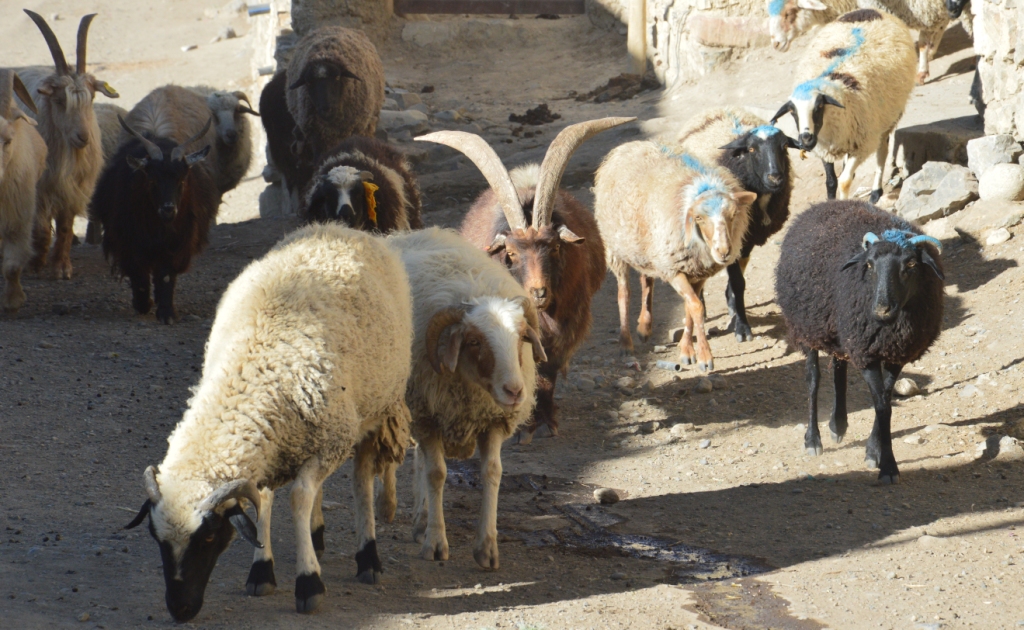
The Spiti Valley has experienced a number of such foreign introductions of sheep, legumes and grass species (Lucerne Orchard grass Tall fescue grass), foreign strains of poplar trees to afforest the desert areas, and popularization of urea molasses mineral blocks and mineral mixture for dairy animals. Such exotics are bound to have their repercussions on the local ecology.
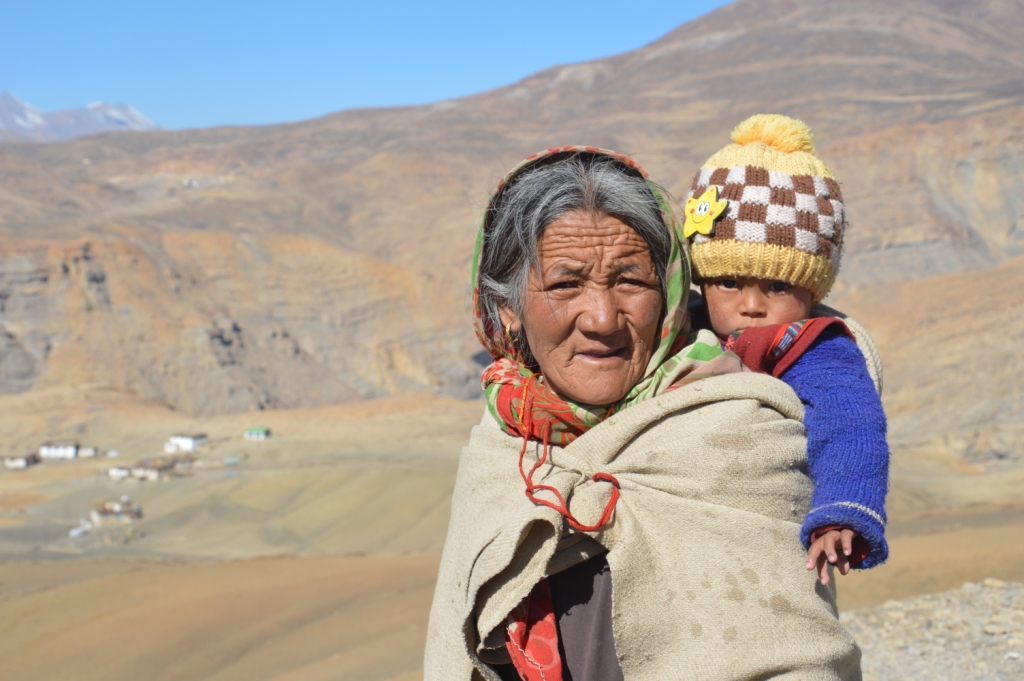
In the neighboring state of Jammu & Kashmir, the High Court has issued an order to chop all the introduced Russian Poplars as they are causing respiratory/health problems among the humans. A great caution is needed before any exotic spp of plant or animal is introduced in highly fragile and ecologically sensitive zone such as Spiti.
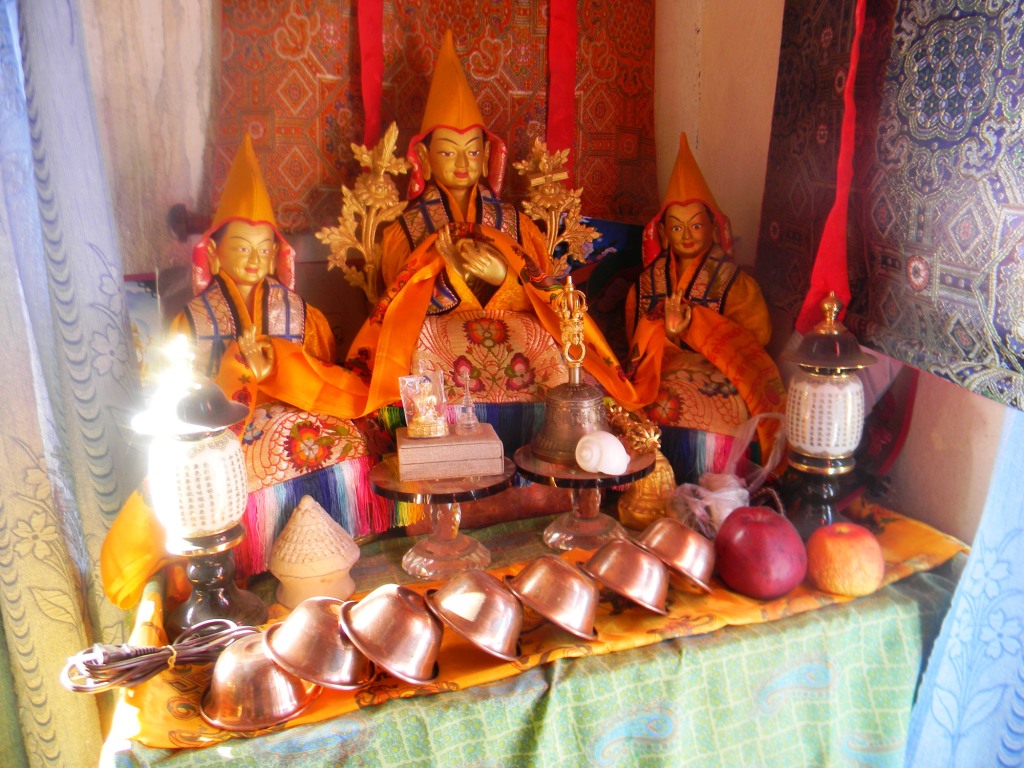
Science is not able to provide a clue when an introduced exotic will become invasive. There are ample examples of Lantana, Leucaena leucocephala, Eucalyptus, Parthenium, etc which were introduced as garden plant or fodder or fast growing spp or even weed, they all ended up in depleting the natural water sources, and harming the local biological diversity.
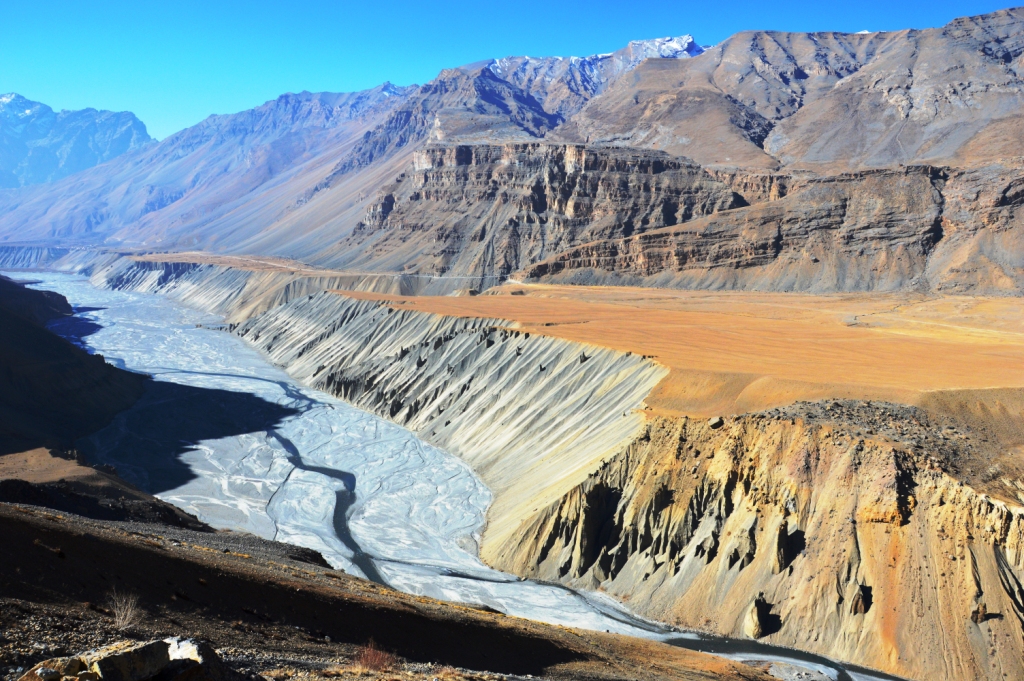
The Kibber Chichim Kiato road moves through very picturesque columns of weathered rocks, popularly called as Hoodoos. These hoodoos are in varying shapes and sizes, some of them very towering sandstone structures chiselled by the dry and fast winds. En route, Ladarcha Maidan is quite a known place for villages fairs where traders from Tibet, Rampur Bushaihr and Laddakh. Now, the venue has shifted to Kaza as there is no trade with Tibet.
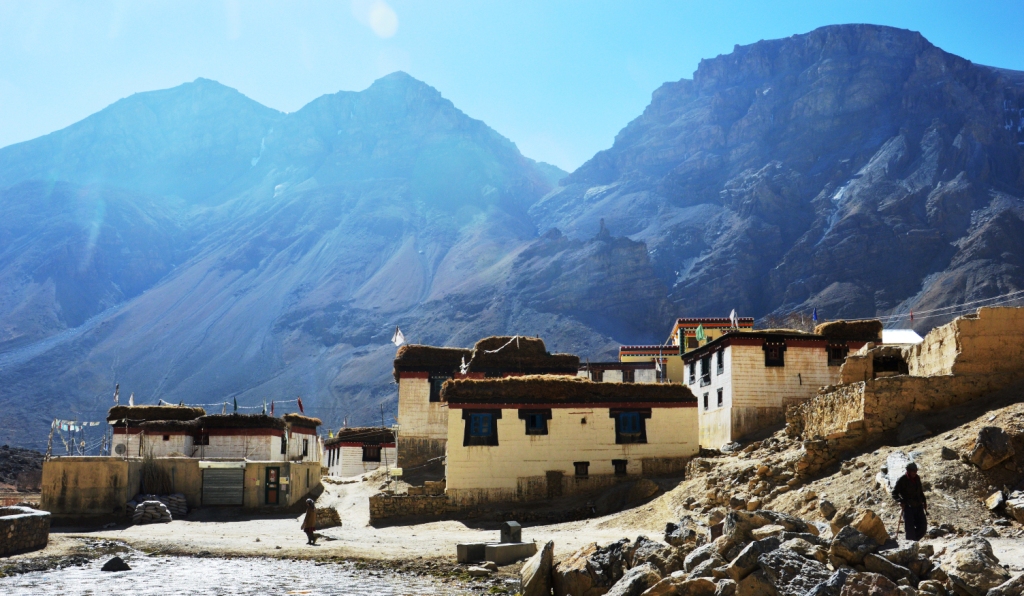
Takli Nala is an Ibex area where Nature Conservation Foundation has been working with local people to restrict/rotate grazing so that the habitat is rejuvenated for the wildlife as well as sheep consumption. Our party could see a herb of about 10 Ibex in this Nala. We reached Kiato by mid-noon. Our friends from NCF said good-bye to us as they were to work with local people for next one week.
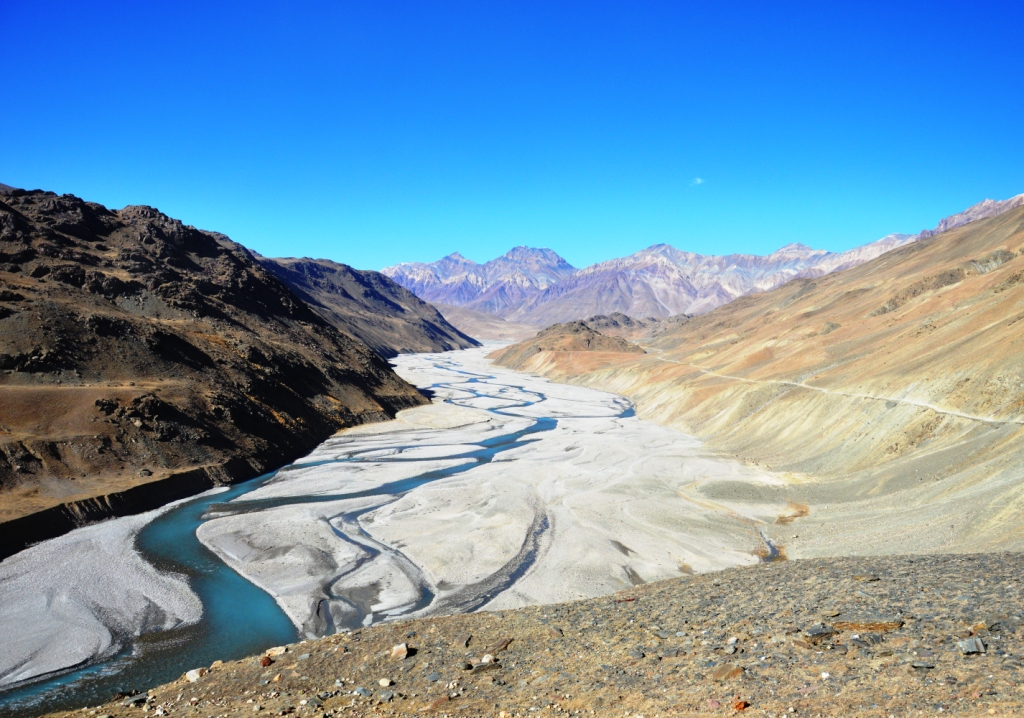
Losar is the last village in Spiti Valley. Usually, it is quite a busy one. However, we could see only one shop selling Maggi noodles in name of lunch. All other Dhabas are closed since mid-October. 5th November, 2017 is still sunny, dry and with blue sky. No snow fall as yet. Vehicle are still moving between Kaza and Manali.
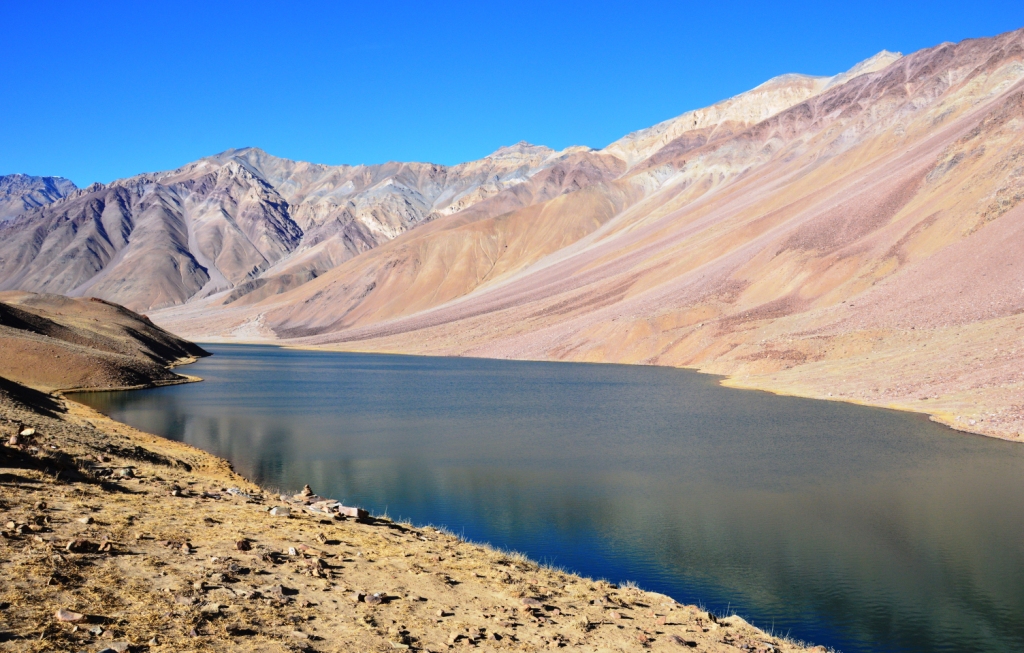
So we ascended to Kunzum La (or Kunzam Pass) and decided to visit Chandratal (about 4,300 metres (14,100 ft). This crescent shape lake is origin of Chandra river (which later becomes Chenab), hence called Chandratal (Lake of the Moon). Mountains of scree and cirque cover the two sides of the Lake. It is good to be here in springtime when the lake side meadows are covered with huge amount of flowers.
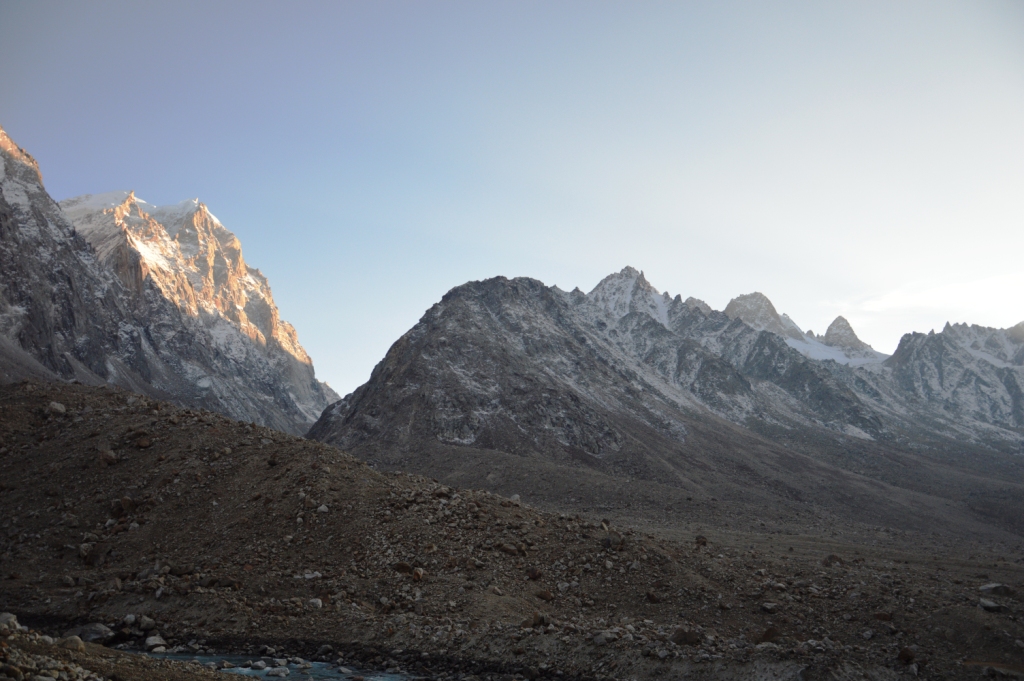
Our journey from Batal (at the valley bottom from where we took detour for the Chandratal) to Chhota Dara and Chataru was extremely bumpy and treacherous with very little of road left. Not a single Dhaba en route. However, setting sun scene on the Bara Shigri Glacier (largest glacier in Hiamchal Pradesh) presents some solace for the arduous road travel.

According to Hugh Whistler’s, an ornithologist and Police office for Kangra district which then extended to Lahul, 1924 account, “Shigri is applied par-excellence to one particular glacier that emerges from the mountains on the left bank of the Chenab. It is said to be several miles long, and the snout reaches right down to the river, lying athwart the customary road from Kullu to Spiti.” At the moment, the glacier is shrinking fast, indicating the prevailing climate changes, the world over.

Chataru Dhaba was a good stopover with hot steaming tea available. All the passing vehicles were stopping to enjoy the hospitality of Chai, Maggi and biscuits. Hereafter, we had switch on the head lights of our vehicle to cross over Rohtang Pass Reached Manali Sylvan Forest Rest House by 8.30 PM. Back to a SMARTISH city.
Jai Ho.
Sanjeeva Pandey is a forester, environmentalist and an active conservationist who was instrumental in attaining the World Heritage Status for Great Himalayan National Park (GHNP) in Himachal Pradesh. He lives in Shimla


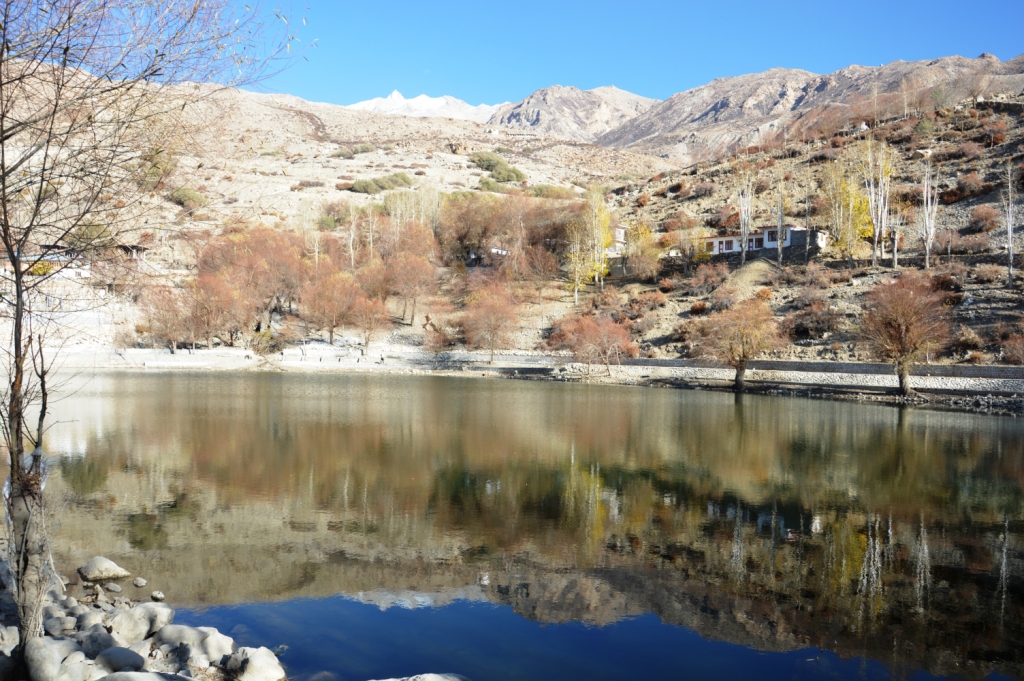



A great photo-essay with spectacular images of this unique landscape. Sanjeeva’s love for nature comes through clearly- may his continuing romance with it keep informing us for many years to come! The image of the Sutlej at Wangtoo is heart rending, however- this majestic, untamed river has been turned into a nallah or drain by our blind quest for power at all costs. I had reported as far back as in 2010 that when all the sanctioned hydel projects on the Sutlej are constructed only about 28 kms of the original river would be free-flowing: all the rest would be diverted to underground tunnels. Most of this appears to have happened. We don’t need the Chinese to block and destroy our rivers- we are doing a good job ourselves!
Just one correction: the Chandratal lake is not the source of the Chandra river- its origins lie in the Baralacha glacier, which is a good two days’ trek away from the lake. Sanjeeva and I had camped near it about ten years ago, when trekking to the Baralacha Pass. Memories that we shall gratefully treasure till we too merge into this God- blessed landscape.
Dear Sir,
Thanks a lot for your comments. I read your blog religiously, and every time when I do so my appreciation and regards for you enhances many more times. You inspired me to write about environment. So, I am starting with this photo essay. My Spiti tour was immensely rewarding. It was a gift to my own self after I submitted my GHNP book MS to Publishers in the last week of October. Enjoyed every moment of the trip: eternal blue sky, vast landscapes with high rising mountains and hoodoes, hordes of blue Sheep and on top of everything sightings of two Nayan above Kibber village (a rare wild sheep, not seen so regulalry in Himachal trans-Himalayas). I would’nt have asked for more.
Many regards,
sanjeeva
Excellent. Got updated on the landscape and its biodiversity
Thanks and regards,
sanjeeva
Life is beautiful.
Appreciate your enthusiasm for such endevours.
Take good care of your health.
All good wishes,
Anita
Thanks Anita,
Book writing has encouraged me this kind of indulgence. Quite happy at it. The bigger version of this photo essay with many more pics is on my Facebook page.
After submitting MS to publishers, I thought of undertaking this tour. The eternal blue sky remained a constant companion all through the trip. Deeply delighted and energized.
Stay blessed and blissed.
Lots of love.
Bhaiya
Great account of your journey! Knowledge with feeling. Induces jealousy and a couple of dark thoughts in my mind.
Dear Asad,
I can very well imagine dark thoughts of your mind. That is bound to happen when a person living in Delhi thinks of azure blue sky of Spiti.
May think of giving it a try next summer. I am sure you can do it.
Best,
sanjeeva
This is wonderfully image studded travel account of Spiti in autumn. Kudos. Brings back many memories of walking, riding (Pin Valley ponies), river crossings hanging from a wire by a yak’s collar bone and nightly feasting on yak-sha and local booze, each superbly complementing the other! Also, of the only time i’ve played a game of baseball with Army people at Kurik and was tempted to slam a ball into Tibet! Just missed it. Look forward to more such photo-essays from Sanjeeva.
Dear Sir,
Good to see your comments. I can recall the time when we attended a Chanka dance in the house of a very prominent resident of Kaza. In a big hall, villagers were enjoying their local brew and dancing to the slow drum beats and cymbals. The place had an atmosphere of great camaraderie.
This chance the best thing that I enjoyed in Kaza was Jalebi. Lots of them which shared with fellow forest officials.
regards, sanjeeva
Very well captured in language and photos. Thanks a lot for sharing.
One of the best tour reports, HIMACHAL IS SCENIC & PRETTY !!!
Sanjeeva is very journalistic in the coverage of the autumn tour of the Spiti Valley and Bara Singhi Glacier.
I truly enjoyed the tour via my Note 5,
about ten thousand miles away from the site. Thank you, Sanjeeva !!!
Can we make this trip in Spring next year ? Best wishes,
Dear Dhiraj,
Yes, you can make a trip in Spring next year. Pl find out the road conditions and do it many stages so that you get acclimatized as you gain elevation.
All the very best,
sanjeeva
Thank you for sharing these beautiful photos and your travel diary.
Thanks for your comments.
regards,
sanjeeva
Wonderful pictures and captivating write up. All the best Sanjeeva.
Lovely pictures…poetic!
Thank you very much for sharing an overwhelming photo journal. Fabulous landscape, that amazes always with its insurmountable beauty. Icherish the hope to cross over and see it for myself – in good time !
Best regards
Lovely photographs!! Mountains galore!
Nice photo